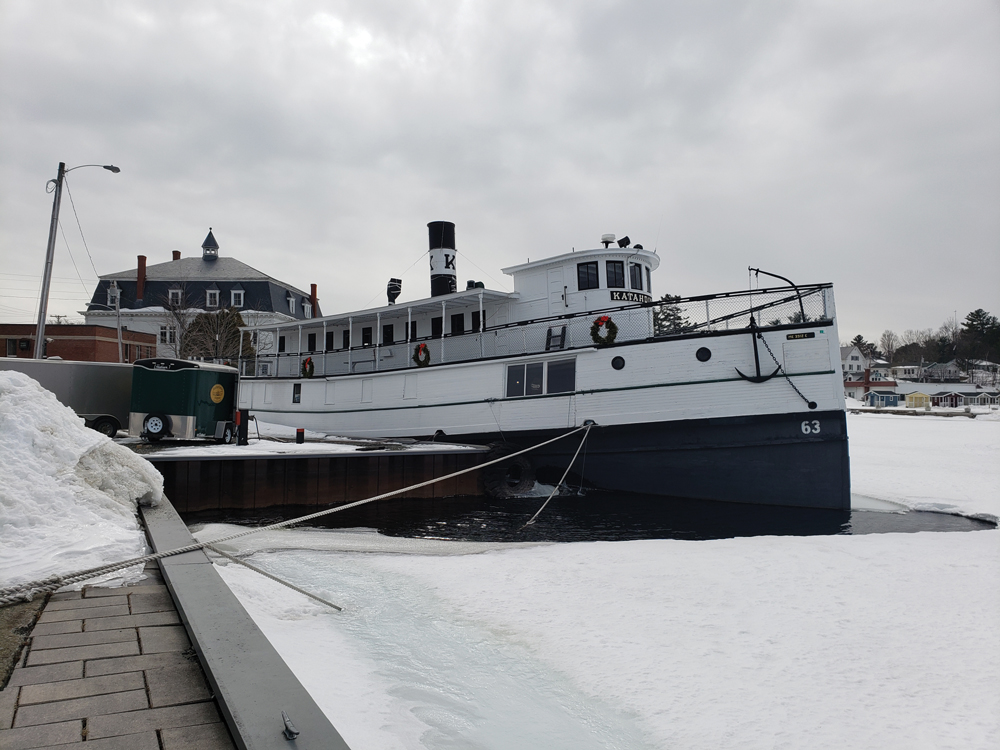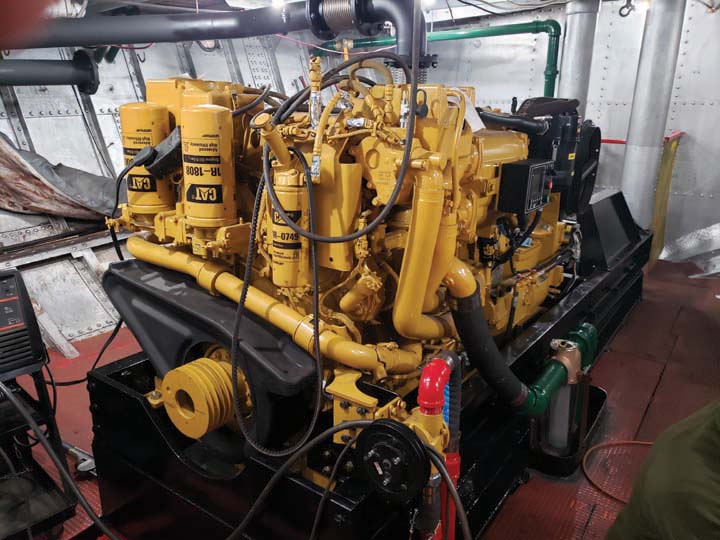
KATAHDIN sitting at her dock on Moosehead Lake in Greenville. You can see that the bubbling system keeps the ice away from the hull even in the extreme depths of winter.

The new C-18 Caterpillar engine sitting in place and being readied for the upcoming season.
GREENVILLE – MOOSEHEAD LAKE – There are a number of historic craft on the coast of Maine, mostly schooners, which draw hundreds of tourists every year to either sail on or just admire. However, one of the best diamonds in the ruff, and draws equally as much admiration, is on an inland lake. She is KATADHIN, fondly known as KATIE, which is operated by the Moosehead Marine Museum on Moosehead Lake in Greenville.
Nearly two years ago, 20 July at exactly 1245 hrs., KATIE developed a serious issue with her number two diesel engine. Liz McKeil, who heads the Moosehead Marine Museum, added, “A day that lives in infamy at the Moosehead Marine Museum. The number two engine dropped a valve and threw a rod and began spewing oil. The vapors from the oil…they couldn’t clap off the air intake because the oil was too hot to get to it so what was happening was that it was pulling in those vapors and so number one engine started to run away. What they did was shut off the fuel to the engine and starved it so that it would eventually shut down. In the mean time a fire started. The crew got a fire hose and aimed it down the stairs from the engineer’s quarters into the engine room. There is a little bit of space above the bulkhead and they got it in there. Normally you don’t put water on an oil fire but I did some research online and what I learned is if you do that and the water comes in over the oil fire the water will vaporize and steam is actually cooler than oil so the steam sinks down and it suppressed the fire. What they did was the right thing and it worked.
“The other thing that didn’t go well at the time, but in the long term was for the best,” added Liz, “was that one of her crew members activated the fire suppression system, but turned the crank the wrong way and it didn’t activate. They were able to get the fire out with the water but he felt bad. However, that saved pretty much all of the gear down in the engine room, because it would have just been toast. That meant we were able to save the last six weeks of the season.”
“The most important thing was it happened just after leaving the dock,” continued Liz, “so the captain was able to get the boat headed back toward the dock. We de-boarded people actually on the town dock with a temporary gang plank. We had about 60 or so people onboard plus eight crew and it was roughly 15 minutes from calling 911 to when everybody was off that boat. Our local fire fighters responded immediately. In a small town like this some first responders were actually downtown and they all ran toward the accident so it was amazing how quick the response was.”
At the time, KATIE was powered with twin Detroit 610s hooked to a single shaft. Now the problem was 610s are post-World War II and finding parts to rebuild engine #2 was not going to be easy. Believe it or not there were three 610s in Eastport, but they had been removed under a grant and could not be used. However, one was found in Southern New England, which had been used as a generator and had just a few hundred hours on it. Liz added, “In the long run the biggest delay was sourcing and receiving parts and the last thing we received was a set of injectors from Vancouver, British Columbia. I will tell you our local guys know their stuff. They explained to me the 610s are pretty simple engines and after getting the parts it only took a couple weeks to rebuild.”
As KATIE continued her cruises the remainder of the summer, Liz was making plans to repower that winter. It was learned that there was money available from the government to replace old engines. The Maine DEP was contacted and money was made available to help with the cost of the new engine. Then she contacted Kevin Hampson at Milton Cat and they made the decision to repower KATIE with a C-18 469 hp Caterpillar diesel engine. She would also receive a new Twin Disc MG516 6 to 1 gear. Then delays occurred and it they were forced to run another year with the old engines and Liz added, “No one slept. Our guys babied that engine. There was some lag in forward gear with the shaft so we had to have somebody down in the engine room to tell the captain when the shaft stopped spinning before he could shift the boat. In the very beginning of the season we had one charter that the captain lost forward propulsion jammed the boat into reverse and tried to back it out of the cove. We got a tow and were worried we weren’t going to be able to get things fixed, but we did.”
This fall the season was cut a week short so they could have some decent weather before winter set in to replace the two 610s with the C-18. With the season completed they had a crew member take up some of the floor boards and with an I-beam system they hoisted the old engines out. The repower was done by The Shipyard at Boothbay Harbor in Boothbay. New engines beds were constructed and installed and by the first week of November the new C-18 was in place. They also replaced one of the two generators on board. Liz explained, “We have two generators, a Generac and a Caterpillar. The Caterpillar was such an old model that we don’t know what model, all the numbers are worn off. We replaced that with a brand new C-4.”
What was the hardest part of the repower for Liz, destroying one of the engines. Under the guidelines from the DEP both engines were supposed to be destroyed, but Liz was able have one of them put into the Museum on display, but that meant the other and the generator had to be broken up.
KATIE was built at Bath Iron Works at Bath in 1914 and then taken apart and brought to Greenville where she was rebuilt and launched. Originally, she was steam powered, but she had been dieselized with a Fairbanks Morse engine in 1922. The 610s had been put in in the 1950s.
There was something else that needed to be looked at and that was her electrical system. Liz had concerns and she asked a couple of local electricians to come and look at the problem and they would not. Liz thought that this was not a good sign and asked The Shipyard at Boothbay Harbor to survey the system. They made some modifications so everything was safe for the summer and asked for bids from a few places. They accepted the bid put in by The Shipyard at Boothbay Harbor and while the repower was happening they would also replace the electrical system.
As the money continues to go out the door Liz is getting ready to do a capital campaign to raise money for the next rainy day. It is also known that KATIE will have to come out of the water in three or four years and that is not an inexpensive proposition.
The first site of the Moosehead Marine Museum was on the other side of the cove where the Black Frog restaurant is located. Liz’s father was one of the first Directors of the Museum. Her father was friends of Lou Hilton, who was a descendant of Louie and Harry Oakes. Liz added, “When I was 16 years old we had a camp on Hartford’s Point and I complained one day that I was bored for probably one time too many. My father said, ‘Well I have something you can do,’ and he dragged me kicking and screaming to the Museum which had just started out and I was typing up labels for the Museum and I had to give tours of the boat. When I came to apply for this job everybody asked me, ‘have you been on the boat before?’ I said, ‘Yeah, I used to give tours on it.’ I gave them the whole history of the boat and I think that is why I got the job. But if you told me at the age of 16 that I was going to come and do this job some 35 years later, I would have told you were crazy.”
Liz continued, “The Museum started out as a real grass roots affair. The Museum bought the boat and originally intended to have it as a floating exhibit. They didn’t intend to cruise with it but they did the original marine survey with Giffy. He gave them their list of stuff to fix and they started fixing it. By the mid-80s they were able to cruise and she’s cruised every year since then. I think the late ‘80s they started doing some deck work and in the ‘90s they re-clad the hull. BIW came up and they did the work pretty much at cost. Shortly thereafter they extended the upper fantail again because it had been removed when Scott Paper was towing logs. At some point there was lower deck work done.”
Over the years the Museum has grown as more items are unearthed in people’s attic pertaining to the history of the lake. They have also been blessed with a number of people who have taken care of the artifacts and set up great exhibits.
The Museum and KATIE have great support. Ticket sales last year were just under $200,000, the best ever; another $25,000 to $40,000 in charters; the galley sales were $50,000 and another $5,000 from gift shop sales. Then members and donors give another $50,000. However, running a vessel like KATIE is not cheap.
“We are spending a ludicrous amount of money right now,” added Liz. “We are so fortunate that we had the money to do the engines and was in a position to borrow so we could do the electrical system. Even though we are not under Coast Guard supervision it behooves us to bring everything up to Coast Guard standards. At this point we are looking at an entire replacement of the upper deck, which is going to cost just over a million bucks,” continued Liz. “The guys from the shipyard, when they went to do the engines, looked at our sea chest and when they took the plug out it broke. They put in a valve so we don’t have to have the plug anymore which is great, but when they were doing it, they said that the sea chest is actually attached to the inner skin not the outer skin. That is going to have to be done when the boat comes out.”
There is strong support for KATIE and if you have not experienced a cruise out on the lake, do not hesitate. Block a day out this summer and head to Greenville and I will guarantee you that you will find the love too.



